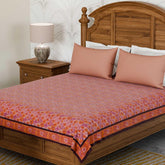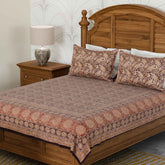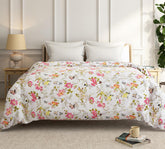Rayon vs Cotton: Key Differences Explained

Imagine that you're walking through a mall, and a flowy summer dress catches your eye. You come closer to feel the fabric — it’s soft, lightweight and cool to touch. You're almost ready to purchase it, and then you check the tag. It says Rayon.
It sounds like a synthetic fabric, but it also feels silk-like and smooth. So what is it, really? Is it good for your skin? Will it keep you cool in the summer? Or is it something you should avoid?
Rayon is one of those fabric names you’ll see everywhere in the market -from sarees and trendy dresses to bed linen. It’s popular, affordable, and often mistaken for cotton at first glance.
While rayon and cotton may look similar, they’re quite different — especially in how they’re made and how they behave across seasons.
Whether you're buying clothes or cushion covers, knowing the difference between rayon and cotton can help you make better choices for your comfort and lifestyle.
In this blog, we’ll break down how each fabric is made, how it feels, and which one might be a better fit for you. Let’s dive in!
Quick Summary
| Features | Cotton | Rayon |
| Source | 100% natural fibre, sourced from cotton plants. No chemicals are required for processing. | Semi-synthetic fibre made from plant-based materials like wood pulp; it undergoes chemical processing. |
| Breathability | Highly breathable and skin-friendly. | Less breathable; can trap heat in warmer weather. |
| Moisture Control & Seasonal Comfort | Excellent for hot and humid climates — absorbs sweat and keeps you cool. | Better suited for mild or cooler weather; may cling to the skin in humidity. |
| Durability | Strong and long-lasting, even after repeated washes. | Weaker, especially when wet. |
| Appearance | Matte, soft texture with a slightly coarse finish. | Smooth, shiny, and drapes like silk. |
| Care | Low maintenance; easy to wash and iron. | Requires gentle care — dry cleaning is often preferred. |
| Eco-friendly | Biodegradable and eco-friendly (especially organic cotton). | Often requires chemical processing, which can negatively impact the environment. |
| Cost | Typically more expensive | Usually cheaper. |
| Best Use | Perfect for everyday wear, bedding, towels and anything that’s washed frequently. | Ideal for flowy garments like sarees, stylish kurtas, or decorative items like table covers, where drape and shine matter. |
Rayon Fabric vs Cotton: What’s The Difference?
1. Fibre Sources: Natural vs Semi-Synthetic
 Cotton is a natural fibre that comes from the cotton plant. These fibres are spun into thread and woven into fabric. As one of the oldest and most widely used materials, cotton is found in everything from sarees and shirts to bed linen and towels.
Cotton is a natural fibre that comes from the cotton plant. These fibres are spun into thread and woven into fabric. As one of the oldest and most widely used materials, cotton is found in everything from sarees and shirts to bed linen and towels.
Cotton is completely natural and doesn't need any chemical processing.
Rayon, on the other hand, is a semi-synthetic fibre. It’s made from natural materials like wood pulp — often sourced from bamboo, eucalyptus, or other trees — but it's processed using chemicals to turn that pulp into soft, usable fibres.
That’s why rayon feels natural but isn’t completely so.
2. Breathability and Comfort: Which Feels Better in Summer?
Feeling uncomfortable due to the hot and humid weather? Your fabric choice can make a big difference.
Cotton is known for being breathable. It allows air to flow easily, absorbs sweat, and feels gentle against the skin. It doesn’t trap heat, which is why it’s ideal for summer clothing, babywear, and bedding.
Rayon, while smooth and cool to the touch, doesn’t breathe as well. In humid conditions, it can hold on to the skin and feel sticky or damp after a while.
Tip: For breathability and comfort in hot weather, our cotton bed covers are the perfect choice as summer bed essentials.
Also Read: Cotton vs Cotton Blend: Which Fabric Should You Choose?
3. Absorbency
Both rayon and cotton can absorb moisture, but they behave differently.
Cotton has excellent absorbency. It soaks up sweat from the skin and allows it to evaporate quickly, keeping you cool and comfortable.
Rayon also absorbs moisture well, but it doesn’t release it as efficiently. It tends to stay damp longer, which can leave the fabric feeling sticky or wet, especially in humid conditions.
Tip: Babies tend to sweat more during summer naps, so our Baby Gift Hampers include soft, absorbent cotton essentials that gently soak up moisture and keep your baby comfy and dry.
4. Durability and Strength: Which Lasts Longer?

Cotton is known for its long-lasting quality. It actually gets softer with every wash while maintaining its strength.
With proper care, cotton can last for years, making it perfect for everyday use.
Rayon, while smooth and elegant, is more delicate. It tends to weaken when wet, and its fibres can stretch or tear if not handled gently. It’s not the best option for heavy use or items that require frequent washing.
Overall, cotton is the more durable fabric — built to last through wear and washes.
Tip: Our Table Runners are designed for daily use. Whether it's curry, dal, or tea spills, the absorbent and sturdy fabric handles it all.
It doesn’t wear out easily and can be washed and reused often — ideal for Indian homes where meals are always lively (and sometimes messy)!
Also Read: Comforter vs Blanket: Which One Is Right for You?
5. Appearance
Rayon has a soft, silky feel with a gentle shine that gives it a luxurious look, which is why it's often called “artificial silk.” It drapes beautifully, holds colour exceptionally well, and has a vibrant appeal.
That’s why you’ll find it often used in stylish kurtis, skirts, flowy dresses, blouses, scarves, and party wear.
Cotton, on the other hand, has a matte, natural finish. While it’s soft and comfortable, it doesn’t offer the same drape or shine as rayon. However, it’s perfect for casual clothing, pillow covers, kids’ wear and table mats.
6. Care and Maintenance

Cotton is easy to care for. You can toss it in the washing machine, and it’s generally safe for the dryer too. However, it does have a tendency to shrink slightly and wrinkle easily, so a quick iron is usually needed to keep it looking crisp.
Rayon, on the other hand, is more delicate. It can shrink, stretch, or lose its shape if not handled gently. Dry cleaning is ideal, but if you prefer washing at home, hand-washing in cold water with mild detergent is best.
Ironing should be done at a low temperature to avoid damage.
Tip: For Hassle-Free Home Care, Check Out Our Machine-Washable Table Napkins.
7. Cost and Availability
Is rayon cheaper than cotton? In most cases, yes.
Rayon is less expensive because it’s cheaper to manufacture and is often used in fast fashion.
Rayon is generally less expensive because it's cheaper to produce and commonly used in fast fashion. Cotton, especially organic or handwoven varieties, can be more costly due to ethical sourcing practices and skilled artisan labour.
So while rayon may cost less upfront, cotton tends to last longer and delivers better value over time.
Also Read: 10 Surprising Benefits of Dream Catchers You Should Know
8. Environmental Impact
 In today’s world, sustainability matters more than ever.
In today’s world, sustainability matters more than ever.
Cotton — especially organic cotton — is biodegradable, renewable, and gentle on the skin. However, conventional cotton farming can be resource-intensive, often requiring large amounts of water and pesticides.
Rayon production involves toxic chemicals that can harm workers, pollute water sources, and lead to deforestation.
If you care for Mother Nature, cotton is the more eco-friendly choice.
Best Uses: When to Choose What?
Still confused about rayon vs cotton? Here's a quick guide to help you choose the right fabric for your everyday needs.
Cotton is best for:
-
Summer clothing
-
Bedsheets & pillowcases
-
Babywear
-
Everyday casuals
-
Towels
Rayon is best for:
-
Flowy dresses
-
Blouses and skirts
-
Fashionable partywear
-
Scarves and stoles
-
Lightweight kurtis
Conclusion
Now that you know the difference between rayon and cotton, you can make a more informed choice based on your needs.
Rayon offers a silk-like drape, soft texture, and vibrant colours — all while being easy on the wallet. It’s perfect for occasions when your outfit needs to make a statement.
Cotton, on the other hand, is light, breathable, and gentle on the skin. That makes it ideal for everyday wear, especially in warm or humid climates.
Ultimately, your choice depends on what you need — style or comfort, daily wear or festive wear, low maintenance or a trendy look. Rayon looks elegant but needs gentle handling. Cotton is reliable, cosy, and easy to maintain.
FAQs On Rayon Fabric Vs Cotton
1. Which is better — rayon or cotton?
It depends on what you need. Cotton is breathable, durable, and eco-friendly, making it ideal for everyday wear. Rayon, with its silk-like drape and vibrant colours, is better suited for occasion-based outfits.
2. Is 100% rayon considered high quality?
Yes, 100% rayon can feel soft and luxurious. However, it’s a delicate fabric that doesn’t handle rough use or frequent washing well — unless it's blended with stronger fibres or marked as high quality.
3. What are the disadvantages of rayon?
Rayon tends to shrink, lose strength when wet, and requires special care. Its chemical-heavy production process can also raise environmental concerns.
4. Which fabric is better for summer — cotton or rayon?
Cotton is better for summer. It’s breathable, moisture-absorbing, and keeps you cool in hot weather. Rayon is soft and lightweight, too, but it can cling to the skin and may not absorb sweat as well in high humidity.
5. Is rayon healthy for the skin?
Rayon is soft, but it may not be as skin-friendly as cotton. Some people with sensitive skin may experience irritation, especially if the rayon is chemically treated or blended with synthetic materials.









 https://eyaas.in/
https://eyaas.in/





Leave a comment
Please note, comments need to be approved before they are published.